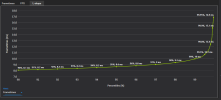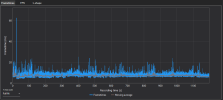IIRC it was around then, perhaps slightly earlier.. I found some emails between myself and Scott Wasson from the Tech Report where we were discussing various ways to capture and present the data from early 2013 - indeed some were linked to a B3D post I made at the time with my thoughts. Unfortunately that seems to fallen *just* off the end of where the B3D history seems to cover, but sounds like the right time-frame. I know other folks were experimenting with similar methods around the same time as well but I'm fairly sure that TR was one of the first to start putting things like frame time graphs and 99%/1% percentile type measurements routinely into their reviews.
I don't think it was specific to crossfire/SLI, but that was certainly one place where it was very obvious that the numbers said things were good but the visual smoothness did not align. There were games that exhibited poor frame pacing at the time as well that were other motivations to try and find a better way to quantify the issues.
[Edit] Found that this is still (sort of) online, which IIRC was one of the most often quoted manifestos around this topic, although there were several follow-ups. Dated 2011:

techreport.com





